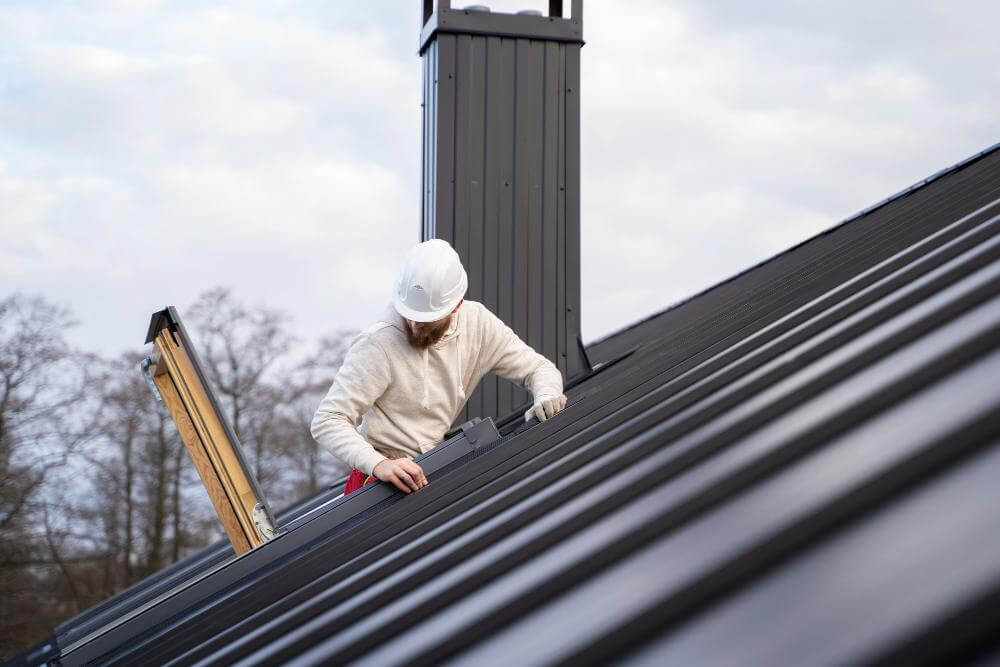If you’re planning a new roof or considering an upgrade, you might’ve heard the term “hip roof” tossed around. But what exactly is a hip roof, and why is it a solid option for homes in Lexington, KY?
With Kentucky’s shifting weather patterns, from heavy summer rain to winter snow and wind, roof shape matters more than you might think.
Key Takeaways
- A hip roof slopes down on all four sides, offering excellent stability and wind resistance.
- It’s a popular choice for Lexington homeowners thanks to its durability and clean look.
- While more complex to build, the long-term benefits often outweigh the upfront cost.
- Proper ventilation and materials are essential for performance in Kentucky’s climate.
What Is a Hip Roof?
This roof has four sloping sides that meet at the top to form a ridge or point. A hipped roof has one ridge and four sloped sides that converge at the peak, creating a unique and symmetrical design. That makes them especially good at handling wind from any direction—an important trait in a region like Lexington where storms can surprise you any time of year.
You’ve probably seen these kinds of roofs without realizing it—they’re common on ranch-style homes and many newer subdivisions across Kentucky. This roof style is often compared to others like the mansard roof, pyramid roof, or tented roof, each offering distinct aesthetics and structural qualities.
Benefits of Hip Roofs in Lexington’s Climate
Lexington homeowners know that Kentucky weather doesn’t play around. Wind, snow, rain—it all hits. These styles naturally deflect wind, reducing uplift pressure. They are specifically designed to withstand high winds, making them ideal for the Lexington environment.
They also shed rain and snow efficiently. This helps prevent water pooling or ice dams, which can lead to leaks and long-term damage. Plus, the symmetrical slope gives the roof extra strength, making it more resilient to structural stress. Hip roofs often require diagonal bracing, which increases construction complexity but enhances stability.
Types of Hip Roofs
Not all hip roofs look the same. Here are a few variations:
- Simple hip roof: The classic design with four equal sides.
- Crossed hip roof: Two hip sections that intersect—often seen in L-shaped homes.
- Hip and valley roofs: Combine hips with valleys for more complex layouts.
- Square hip roof: A compact version with roof planes meeting at a central peak.
- Pavilion roof: A square structure with steeply pitched slopes often used on gazebos or additions.
- Half hipped roofs: A variation where the gable ends are truncated with small hip sections.
These roof types offer homeowners a range of options for both function and style.
What to Know Before You Build a Hip Roof
A hip roof is typically more expensive to frame and build than a gable roof due to its complexity. But many homeowners in Lexington see it as a worthwhile investment for the added stability and weather protection.
Ventilation can also be a bit more complicated. Since hip roofs don’t have high peaks like gable roofs, it’s crucial to work with a roofing contractor who understands how to install proper vents.
Best Roofing Materials for Hip Roofs in Kentucky
At Barrier Roofs, we stand by materials that can handle Kentucky’s ever-changing weather. Here’s why our recommended roofing products make a difference:
- Barrier Roofs recommends durable, weather-resistant roofing materials for any roofing system in Kentucky.
- Owens Corning shingles—available in a range of styles—pair beautifully with hip roofs and provide long-term performance. They’re also backed by strong warranty coverage, which we help you register and manage.
Because hip roof design includes more roof planes and vertical wall extensions, choosing high-quality shingles helps minimize issues with water intrusion and wind damage. This is especially important in homes with solar panels or steeply pitched slopes where the roof extends over key exterior walls.
Whether you’re adding a small gable, installing a new roof, or evaluating roof vs attic space trade-offs, the right materials matter.
Why Lexington Homeowners Choose Barrier Roofs
Our local team understands the challenges of Central Kentucky weather. We’ve installed hip roofs and gable roof designs across Lexington, Corbin, Somerset, and beyond. From free inspections to insurance support, we make the process smooth from start to finish.
Our Owens Corning Platinum Preferred status means you get top-tier materials and coverage. Plus, we offer flexible financing and discounts for military families and first responders. Whether you have a hip and gable roof combo, a small hip roof section, or are exploring roof types with horizontal ridge lines or vertical sides, we bring expert guidance to every job.
Ready to Learn More?
Thinking about a hip roof for your Lexington home? Contact Barrier Roofs today to schedule your free inspection. Our team is here to help you make the best choice for your home, your budget, and Kentucky’s unpredictable seasons. Whether you’re debating roof vs attic space needs, hip roof design, or comparing hip roofs to other options like box gable, cross gable, or type of roof alternatives, we’re here to help.
FAQs About Hip Roofs
Q: Is a hip roof better than a gable roof for wind resistance?
A: Yes, hip roofs tend to perform better in strong winds because their shape reduces uplift on all sides. Their sloping sides and sides slope downward offer excellent performance in high winds.
Q: Are hip roofs more expensive to build?
A: Generally, yes. They require more framing and labor, plus more roofing materials, but many homeowners see it as a good investment.
Q: What kind of homes use hip roofs?
A: Everything from ranch-style homes to modern builds. They’re especially popular in neighborhoods with strict aesthetic codes. Pavilion roofs, cross gable, and dutch gable designs are also frequently seen in Lexington.
Q: Does Barrier Roofs offer free inspections?
A: Absolutely. We’ll assess your current roof and provide honest recommendations—no pressure, just facts.



